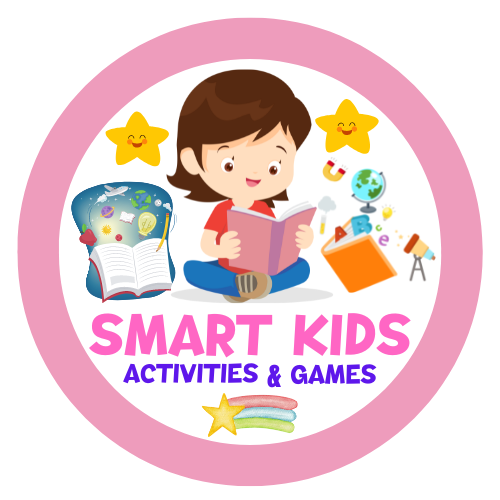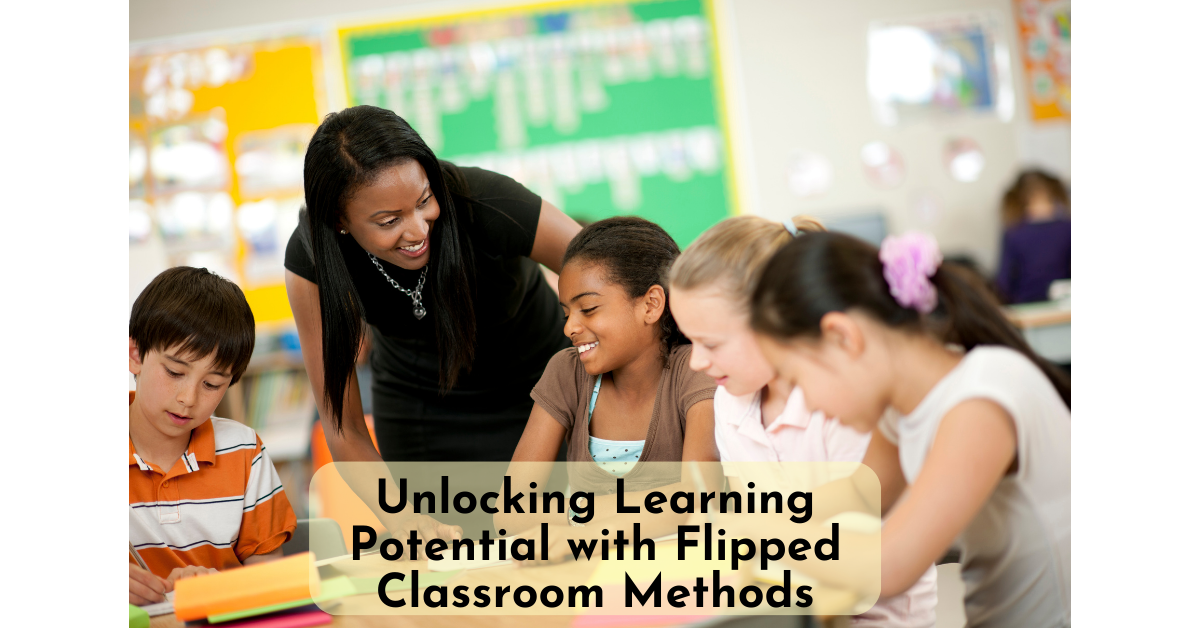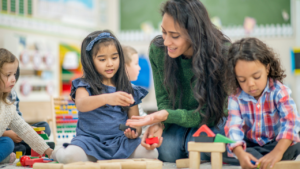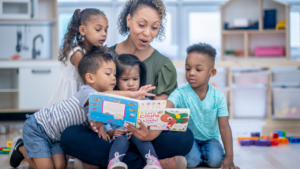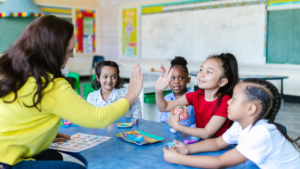Key Takeaways:
- Flipped classrooms reverse the traditional classroom structure, allowing students to learn new material outside of class and using class time for interactive activities.
- Benefits of flipped classrooms include personalized learning, improved student engagement, and the development of higher-level skills.
- Challenges of implementing flipped classrooms can be overcome through proper planning, support, and effective classroom management strategies.
- Teachers should prepare instructional materials and plan engaging class activities to create a successful flipped classroom environment.
- Clear communication, setting expectations, and emphasizing the benefits of the flipped approach are crucial in preparing students for the change.
What is a Flipped Classroom?
A flipped classroom is an instructional strategy that revolutionizes traditional teaching methods. In this approach, classroom activities are transformed, with instructional tasks usually completed outside of the class. This shift allows students to learn new concepts independently at home, through video lectures or other resources, promoting personalized learning. Class time is then devoted to problem-solving, collaborative activities, and discussions, fostering active learning and critical thinking skills. The flipped classroom model redefines the role of a teacher. Instead of being the primary source of information, educators become facilitators and mentors, guiding students through their learning journey. By moving traditional homework activities to class time, students have immediate access to assistance and can engage in meaningful discussions with their peers and the teacher. This interactive approach promotes deeper understanding and enhances student engagement, as they actively participate in the learning process. This innovative instructional strategy also emphasizes problem-solving skills. By dedicating class time to problem-solving activities, students can apply the concepts they learned independently, fostering a deeper understanding of the material. This hands-on approach helps students develop critical thinking skills and prepares them for real-world challenges.Flipped classrooms allow for a student-centered learning environment, where students take ownership of their education and have the opportunity to engage in active learning, collaboration, and problem-solving.
Benefits of Flipped Classrooms
Flipped classrooms offer numerous benefits that cater to different learning styles and promote higher-level skills, deeper understanding, and self-directed learning. By allowing students to learn at their own pace, flipped classrooms accommodate various learning styles and speeds. This personalized approach enables students to grasp concepts more effectively and encourages a deeper understanding of the material. In addition to personalized learning, flipped classrooms also foster the development of higher-level skills. Through hands-on activities and discussions during class time, students are challenged to think critically, solve problems, and collaborate with their peers. This active learning approach enhances their ability to apply knowledge and develop essential skills such as leadership and problem-solving. Another significant benefit of the flipped classroom model is the promotion of self-directed learning. By requiring students to learn new material outside of class, they become responsible for their own learning and must come to class prepared. This cultivates a sense of independence and accountability, preparing them for future academic and professional endeavors.| Benefits of Flipped Classrooms | Description |
|---|---|
| Different Learning Styles | Accommodate the diverse learning preferences and speeds of students. |
| Higher-Level Skills | Foster critical thinking, problem-solving, and collaboration. |
| Deeper Understanding | Promote a thorough comprehension of the material through hands-on activities. |
| Self-Directed Learning | Encourage students to take responsibility for their own learning and come prepared to class. |
Overcoming Challenges of Flipped Classrooms
Implementing a flipped classroom comes with its fair share of challenges and objections. Educators may encounter concerns regarding technology dependence, resistance to change, workload, parental concerns, student responsibility, and classroom management. However, these challenges can be effectively addressed through various strategies and approaches. One of the main objections to flipped classrooms is the perceived reliance on technology. Some educators and parents may worry that students will become too dependent on technology for their learning. To overcome this challenge, it is important to provide access to reliable technology resources and ensure that students receive proper guidance on how to use them effectively. Resistance to change is another common challenge when implementing a flipped classroom. Some educators may be hesitant to adopt this new approach due to familiarity with traditional teaching methods. To address this, it is recommended to start small and gradually implement the flipped approach, allowing educators time to adjust and gain confidence in the methodology.“The flipped classroom requires a shift in mindset for both educators and students. It is important to provide ongoing support, guidance, and professional development to help teachers embrace the change and navigate any challenges that may arise.”The workload involved in creating video lectures and interactive activities can also be a concern for educators. To alleviate this challenge, it is essential to utilize existing resources and collaborate with colleagues to share the workload. Additionally, implementing effective classroom management strategies can help ensure a smooth transition and maximize student engagement.
| Challenges | Objections |
|---|---|
| Technology dependence | Some educators fear over-reliance on technology for learning |
| Resistance to change | Many educators are comfortable with traditional teaching methods |
| Workload | Creating video lectures and interactive activities can be time-consuming |
| Parental concerns | Parents may have questions about their role in supporting their child’s learning at home |
| Student responsibility | Students need to adjust to self-directed learning and taking ownership of their education |
| Classroom management | Managing classroom activities effectively can be challenging in a flipped classroom |
Preparing Yourself for the Flip
Implementing a flipped classroom requires careful planning and preparation. As an educator, you need to develop instructional materials that students can engage with outside of class. This may include creating video lectures, interactive online modules, or providing reading materials. The goal is to provide students with the necessary content to acquire foundational knowledge before coming to class. When planning class activities, focus on promoting active learning and collaboration. Think about how you can engage students in problem-solving activities, discussions, and group projects. By leveraging the flipped model, you can transform your classroom into a dynamic learning environment where students actively participate in their own education. It’s important to experiment and iterate as you implement the flipped classroom approach. Every class is different, and what works for one may not work for another. Take the time to reflect on your students’ responses and adjust your instructional strategies accordingly. By continuously refining your approach, you can find what works best for your specific class and maximize the benefits of the flipped classroom.Preparing Yourself for the Flip
| Key Considerations | Actions |
|---|---|
| Develop instructional materials | Create video lectures, interactive modules, or reading materials |
| Plan engaging class activities | Design problem-solving activities, discussions, and group projects |
| Experiment and iterate | Reflect on student responses and refine your instructional strategies |
Preparing Your Students for Change
When implementing a flipped classroom approach, it is vital to prepare your students for the changes they will experience. Clear communication and setting clear expectations are key to ensuring a smooth transition. By emphasizing the benefits of the flipped classroom model, such as personalized learning, improved engagement, and the development of higher-level skills, students can develop enthusiasm for this new learning format. Encourage open communication with your students, allowing them to voice any concerns or questions they may have. This will help address any misconceptions or hesitations they may have about the flipped classroom approach. By fostering a supportive and collaborative learning environment, students will feel more comfortable and motivated to take responsibility for their own learning. Stress the importance of student responsibility in the flipped classroom model. Make it clear that students are expected to come to class prepared and complete assignments on time. By empowering students to take ownership of their learning, they will become more actively engaged and invested in their educational journey.Table: Benefits of the Flipped Classroom Model
| Benefits | Description |
|---|---|
| Personalized Learning | Students can learn at their own pace, accessing resources outside of class to support their individual needs. |
| Improved Engagement | Interactive in-class activities and discussions promote active participation, fostering deeper understanding and critical thinking. |
| Higher-Level Skills | The flipped classroom model develops essential skills such as problem-solving, leadership, and collaboration. |
Common Objections and Solutions
While the flipped classroom model offers numerous benefits, there are some common objections and concerns that educators may have when considering its implementation. Addressing these objections and finding suitable solutions is crucial to ensure a successful adoption of this innovative approach to education.1. Technology Reliance
One objection to the flipped classroom model is the perceived reliance on technology. Some educators may worry that not all students have access to the necessary devices or internet connection to engage with the online resources. To overcome this challenge, schools can provide access to technology resources, such as computer labs or loaner devices, to ensure equitable access for all students. Additionally, offering alternative offline resources, such as printed materials or flash drives, can help accommodate students who may not have reliable internet access at home.2. Resistance to Change
Change can be met with resistance, and implementing a flipped classroom requires a shift in traditional teaching methods. To address this concern, it is essential to provide ongoing support and professional development opportunities for educators. Training sessions, workshops, and coaching can help teachers feel more confident in embracing the flipped classroom model and effectively adapting their instructional strategies.3. Workload
Creating video lectures and interactive activities for the flipped classroom can initially seem overwhelming for educators. To alleviate this concern, teachers can start small and gradually implement the flipped approach. Utilizing existing resources, such as educational videos or online platforms, can also reduce the workload. Collaboration among educators can further lighten the load by sharing resources and ideas.4. Parental Support
Parental involvement in supporting their child’s learning at home may raise concerns for some educators. To ensure parental support, clear communication is key. Teachers can provide detailed explanations of the flipped classroom model to parents, emphasizing the benefits it offers for student learning. Schools can also offer resources and guidance for parents to help them understand their role and provide assistance to their children in navigating the flipped learning environment.5. Student Adjustment and Classroom Engagement
Students may initially struggle with the transition to a flipped classroom, as it requires self-directed learning and active engagement during class time. To support student adjustment, educators can provide clear guidelines and expectations for the flipped learning environment. They can also incorporate varied strategies for classroom engagement, such as hands-on activities, group discussions, and collaborative projects, to keep students actively involved in their learning process. By addressing these common objections and concerns, educators can successfully implement the flipped classroom model, unlocking the full potential of their students and fostering an engaging and dynamic learning environment.Table
| Objections | Solutions |
|---|---|
| Technology Reliance | Provide access to technology resources and alternative offline materials |
| Resistance to Change | Offer ongoing support and professional development opportunities |
| Workload | Start small, utilize existing resources, and encourage collaboration among educators |
| Parental Support | Ensure clear communication and provide resources and guidance for parents |
| Student Adjustment and Classroom Engagement | Provide clear guidelines and expectations, incorporate varied engagement strategies |
Professional Development and Support for Flipped Classrooms
Implementing a flipped classroom requires educators to have the necessary knowledge, skills, and support to effectively utilize this innovative approach to education. Strobel Education offers a range of professional development resources and support to help educators implement and succeed with the flipped classroom model. One option for professional development is our self-paced online courses. These courses provide educators with comprehensive training on the flipped classroom model, covering topics such as instructional strategies, content development, student engagement, and technology integration. Through interactive modules, educators can learn at their own pace and gain practical skills to implement the flipped classroom in their own classrooms. In addition to online courses, Strobel Education also offers virtual workshops and on-site professional development. These opportunities allow educators to engage in collaborative learning experiences, interact with experts in the field, and receive personalized guidance and support. These hands-on workshops and on-site visits provide educators with the opportunity to deepen their understanding of the flipped classroom model and receive feedback on their implementation strategies.| Professional Development and Support | Details |
|---|---|
| Self-Paced Online Courses | Flexible learning options with comprehensive training on the flipped classroom model. |
| Virtual Workshops | Engaging and interactive learning experiences with experts in the field. |
| On-Site Professional Development | Personalized guidance and support tailored to educators’ specific needs. |
Best Practices for Flipped Classrooms
Implementing a flipped classroom requires careful planning and consideration of several best practices. By following these guidelines, educators can create a successful flipped classroom environment that enhances student engagement, promotes active learning, and integrates technology effectively. 1. Planning: Before implementing a flipped classroom, it is essential to plan the curriculum and instructional strategies. Identify the key concepts that students will learn outside of class and determine the most effective ways to deliver that content, such as through video lectures or interactive online modules. Create a schedule that outlines when students will watch the videos and complete assignments, and plan engaging in-class activities that reinforce the material. 2. Content Development: Develop high-quality instructional materials that students can access outside of class. This may include recorded video lectures, online readings, or interactive multimedia presentations. Ensure that the content is clear, concise, and aligned with the learning objectives. Consider using a variety of resources to cater to different learning styles and provide opportunities for students to engage with the material in different ways. 3. Student Engagement: Foster student engagement during class time by designing activities that promote active learning and collaboration. Encourage students to ask questions, participate in discussions, and solve problems together. Incorporate hands-on activities, group work, and real-world applications of the concepts. By creating an interactive and engaging learning environment, students will be actively involved in their own learning process. 4. Technology Integration: effectively integrate technology into the flipped classroom model to enhance content delivery and student learning. Utilize video platforms, learning management systems, and interactive online tools to deliver instructional materials and facilitate student interactions. Provide clear instructions and support for accessing and navigating these technologies, ensuring that students can easily engage with the content outside of class. By following these best practices, educators can create a flipped classroom environment that maximizes student learning, engagement, and critical thinking. With careful planning, content development, and technology integration, the flipped classroom model has the potential to revolutionize education and unlock the full potential of students.The Role of Video in Flipped Classrooms
In the flipped classroom model, video plays a pivotal role in enhancing student engagement and improving retention of material. By leveraging video lectures and instructional videos, educators create an interactive and dynamic learning experience. Videos provide a visually stimulating and engaging medium for delivering new concepts, allowing students to learn at their own pace and review material as needed. The use of video in the flipped classroom model has been shown to foster a deeper understanding of the subject matter and promote critical thinking skills. One of the key advantages of using video in flipped classrooms is its ability to engage students on a visual and auditory level. Videos can incorporate visuals, graphics, and animations that help clarify complex concepts and engage students’ visual and auditory senses. This multisensory approach to learning enhances comprehension and retention, ensuring that students grasp the material more effectively than through traditional text-based methods. Furthermore, video lectures and instructional videos can be easily accessed by students outside of class, allowing them to review content at their own convenience. This flexibility empowers students to take ownership of their learning and revisit difficult concepts as needed. By providing students with the ability to pause, rewind, and replay videos, educators enable personalized and self-directed learning, catering to the diverse needs and learning styles of individual students.| Benefits of Video in Flipped Classrooms | Examples |
|---|---|
| Enhanced engagement | Engaging animations and graphics in instructional videos |
| Improved retention | Visual and auditory learning through video lectures |
| Flexible learning | Access to video content outside of class |
| Personalized learning | Ability to pause, rewind, and replay videos |
Considerations for Implementing a Flipped Classroom
Implementing a flipped classroom requires careful planning and consideration. Educators must take into account various factors to ensure a successful implementation of this innovative approach to teaching and learning. Here are some key considerations to keep in mind:- Planning: Before flipping the classroom, educators need to thoroughly plan the instructional materials for students to engage with outside of class. This may include creating video lectures, selecting relevant resources, or preparing interactive activities. By having a detailed plan in place, teachers can effectively guide students’ learning journey.
- Resources: Implementing a flipped classroom requires access to technology resources and infrastructure. Educators should ensure that students have the necessary tools to access online materials, such as reliable internet connections and devices. Additionally, teachers may need support and training to effectively integrate technology into their instructional strategies.
- Technology Support: Flipped classrooms heavily rely on technology for delivering instructional content and facilitating student engagement. It is essential to have dedicated technical support available to address any issues that may arise. This support can range from troubleshooting technical difficulties to providing training on the tools and platforms used in the flipped classroom.
- Parental Involvement: Educators should actively involve parents in the flipped classroom model. Clear communication with parents about the changes in the learning format, their role in supporting their child’s learning at home, and the benefits of the flipped approach can foster a positive and supportive learning environment. Providing resources and guidance for parents can help them effectively support their child’s learning journey.
Table: Considerations for Implementing a Flipped Classroom
| Consideration | Description |
|---|---|
| Planning | Thoroughly plan instructional materials and activities for students to engage with outside of class. |
| Resources | Ensure access to technology resources and infrastructure for students to access online materials. |
| Technology Support | Provide dedicated technical support to address any issues related to technology integration. |
| Parental Involvement | Actively involve parents by communicating the changes, benefits, and providing resources and guidance. |
Conclusion
In conclusion, the flipped classroom model offers a transformative approach to education that enhances student engagement, promotes active learning, and fosters critical thinking. By reversing the traditional classroom structure and utilizing video lectures and interactive activities, educators can unlock the full potential of their students and create a dynamic and impactful learning environment. This innovative method of personalized learning allows students to learn at their own pace, accommodating different learning styles and promoting a deeper understanding of the material. By shifting the focus from passive listening to active problem-solving and collaboration, flipped classrooms develop higher-level skills and cultivate a sense of self-directed learning. Implementing a flipped classroom requires careful planning, support, and ongoing professional development. Educators need to effectively communicate the changes to students and set clear expectations, emphasizing the benefits such as improved engagement and the development of critical skills. By integrating technology and incorporating best practices, educators can successfully implement the flipped classroom model and provide students with an enriching and inclusive learning experience.FAQ
What is a flipped classroom?
A flipped classroom is an instructional strategy where students learn new material outside of class through video lectures or other resources, and then use class time for active learning and application.
What are the benefits of flipped classrooms?
Flipped classrooms accommodate different learning styles, develop higher-level skills, promote a deeper understanding of the material, and foster self-directed learning.
What challenges may educators face when implementing a flipped classroom?
Educators may face challenges such as concerns about technology dependence, resistance to change, workload, parental support, student adjustment, and classroom engagement. However, these challenges can be addressed through various strategies.
How can teachers prepare for implementing a flipped classroom?
Teachers can plan and prepare by developing instructional materials for students to engage with outside of class and planning engaging class activities that promote active learning and collaboration.
How can educators communicate the benefits of the flipped classroom to students?
Educators can communicate the benefits by setting clear expectations, emphasizing personalized learning and improved engagement, and encouraging students to take responsibility for their learning.
What are some common objections to the flipped classroom model and how can they be addressed?
Common objections include concerns about technology reliance, resistance to change, workload, parental support, student adjustment, and classroom engagement. These objections can be addressed through various strategies such as providing access to technology resources and offering support and guidance to parents.
Where can educators find professional development and support for implementing flipped classrooms?
Strobel Education offers a range of services and resources, including self-paced online courses, virtual workshops, on-site professional development, and ongoing coaching.
What are some best practices for flipped classrooms?
Best practices include careful planning, developing engaging content, promoting student engagement and collaboration, and effectively integrating technology.
What role does video play in flipped classrooms?
Video lectures and instructional videos play a crucial role in flipped classrooms as they engage students effectively and improve retention of material.
What considerations should educators keep in mind when implementing a flipped classroom?
Educators should consider factors such as planning, available resources, technology support, parental involvement, and effective communication and collaboration among all stakeholders.
Source Links
- https://www.panopto.com/blog/preparing-to-flip-a-classroom-heres-what-to-plan-for/
- https://strobeleducation.com/the-flipped-classroom-common-challenges/
- https://www.epiphan.com/blog/what-is-a-flipped-classroom/

